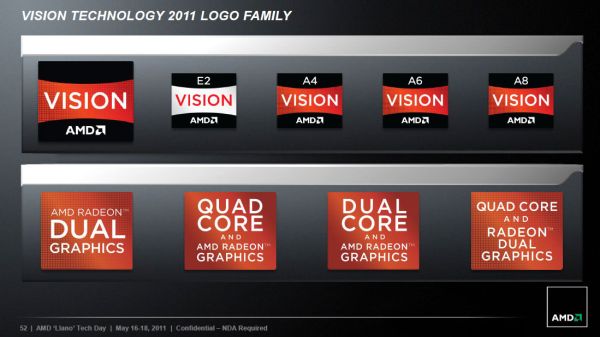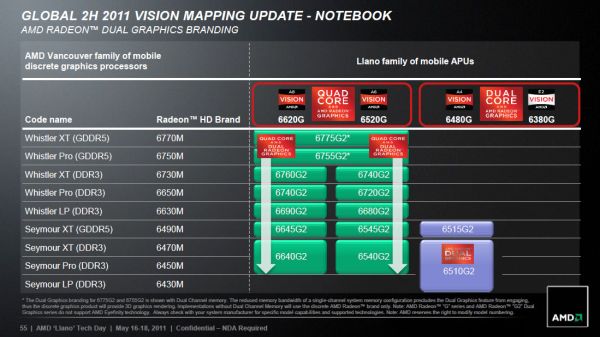The AMD Llano Notebook Review: Competing in the Mobile Market
by Jarred Walton & Anand Lal Shimpi on June 14, 2011 12:01 AM ESTIntroducing Mobile Llano
Anand has provided our coverage of Llano’s architecture and he’ll have a preview of desktop performance, but he’s leaving the mobile coverage to me (Jarred). At a high level, the breakdown of Llano is really quite simple: take a K10.5 series CPU core (dual- or quad-core), pair it up with a DX11 capable GPU core similar to AMD’s Redwood line (5600/5600M or 6500M), and then mix in power gating and Turbo Core; bake everything in a 32nm process and you’ve got Llano. Easier said than done, of course, as K10.5 parts previously used a 45nm process while Redwood used 40nm, so AMD had plenty of work to do before they could realize the simplistic overview I just described; the result is what matters, though, so let’s break out our spoons and see how the pudding tastes. Here’s the overview of the mobile A-series APUs launching today.
| AMD A-Series Fusion APUs for Notebooks | |||||||
| APU Model | A8-3530MX | A8-3510MX | A8-3500M | A6-3410MX | A6-3400M | A4-3310MX | A4-3300M |
| CPU Cores | 4 | 4 | 4 | 4 | 4 | 2 | 2 |
| CPU Clock (Base/Max) | 1.9/2.6GHz | 1.8/2.5GHz | 1.5/2.4GHz | 1.6/2.3GHz | 1.4/2.3GHz | 2.1/2.5GHz | 1.9/2.5GHz |
| L2 Cache (MB) | 4 | 4 | 4 | 4 | 4 | 2 | 2 |
| Radeon Model | HD 6620G | HD 6620G | HD 6620G | HD 6520G | HD 6520G | HD 6480G | HD 6480G |
| Radeon Cores | 400 | 400 | 400 | 320 | 320 | 240 | 240 |
| GPU Clock (MHz) | 444 | 444 | 444 | 400 | 400 | 444 | 444 |
| TDP | 45W | 45W | 35W | 45W | 35W | 45W | 35W |
| Max DDR3 Speed |
DDR3- 1600 DDR3L- 1333 |
DDR3- 1600 DDR3L- 1333 |
DDR3- 1333 DDR3L- 1333 |
DDR3- 1600 DDR3L- 1333 |
DDR3- 1333 DDR3L- 1333 |
DDR3- 1333 DDR3L- 1333 |
DDR3- 1333 DDR3L- 1333 |
There are two different power envelopes for Llano right now: 35W and 45W. The former models end with an M while the latter end in MX. Don’t let the relatively high TDPs fool you, as similar to Intel we’re looking at maximum TDP while idle and low-load TDP will be far lower. Based on battery life, it appears that the entire test notebook consumes around 7.42W at idle. By comparison, a slightly larger dual-core SNB notebook consumes around 7.68W when idle, so we’re very close to parity at idle. As noted earlier, all APU models come with 1MB L2 cache per core, and Turbo Core allows for cores to clock up to higher values under the right circumstances. That could prove important, as clock-for-clock K10.5 cores can’t hope to keep up with Sandy Bridge, and Sandy Bridge parts are already clocking significantly higher.
On the CPU side of the equation, there are currently only dual-core and quad-core parts, so tri-core appears dead (or at least MIA for now). The other part of the APU is the GPU cores, and here there are three options. The A6 and A8 APUs are both quad-core, but A6 has 320 Radeon cores clocked at 400MHz compared to 400 cores at 444MHz—so the 6620G is potentially 40% faster. A4 APUs trim the GPU further, with 240 cores clocked at 444MHz, and they’re the dual-core parts. The 6620G could be up to 67% faster than 6480G, under the right circumstances. As Anand mentioned, right now all of the A-series APUs are coming from the “big Llano” die, but in the future we’ll see the A4 production shift to “little Llano” instead of using harvested die.
Vision and Radeon Branding
For 2011, AMD is simplifying their Vision branding with Llano, skipping the Premium, Ultimate, and Black modifiers and instead referring to the APU. Vision E2 refers to the dual-core E-series APUs, while the A4, A6, and A8 lines correlate directly with the A-series APUs. The Radeon brand continues as an important asset, so there will be sticker options to promote quad-core and dual-core CPUs with Radeon graphics. What about the Dual Graphics, though?
With the integrated GPU finally able to approach the performance of midrange mobile GPUs, AMD is making a return to hybrid CrossFire (IGP and a dGPU working together), though the official name is now apparently “Radeon Dual Graphics” or just "Dual Graphics"; we’ve also heard it referred to as “Asymmetrical CrossFire”, and we’ll use any of these terms throughout this article.
We first saw an attempt at hybrid CrossFire with the HD 2400 and the 790 chipset, and later that extended to HD 3400 cards, but it never really impressed as it was limited to desktops and you could still get far better performance by spending an extra $10 to upgrade from a 3400 to a 3600 dGPU. The 6620G fGPU is several times more powerful than the old HD 4250 IGP, making CrossFire potential useful, especially on laptops where the power savings from shutting off the dGPU are very significant.
With Radeon Dual Graphics, AMD introduces more brands. The various Fusion GPUs (fGPUs) only work in CrossFire with specific discrete GPUs (dGPUs)—nearly all of the 6400M, 6600M, and 6700M line are eligible—giving rise to several new Radeon names. If you start with a base of a Radeon HD 6620G and add a Radeon HD 6770M to it, the resulting combination is now called a Radeon HD 6775G2. Pair it with a 6750M and you get a 6755G2. The entirety of the list is depicted in the slide from above. For now these names are just going to be listed on the notebook spec sheet, the drivers themselves will report the actual GPU you have driving the panel you're connected to. AMD is still working out the right way to expose these names through software to avoid confusion.












177 Comments
View All Comments
Shadowmaster625 - Monday, June 20, 2011 - link
Can you try setting the affinity manually so that it has to use only one core? I notice that even though I'm running only one thread, that thread will jump around to all my available cores, making them all look like they are running at 25%. Maybe by the time AMD's turbo kicks in, the thread is already moved to another core.GullLars - Tuesday, June 14, 2011 - link
Looking forward to the re-test with an SSD.IMHO all machines over $600 meant for general purpose use in 2011 should include at least a 32GB SSD of Indilinx Barefoot performance or better.
My laptop from 2007 with 2,2GHz C2D and a 32GB Vertex (retrofitted in 2009) still wipes the floor with new $800+ laptops with HDD-only for general use.
JarredWalton - Tuesday, June 14, 2011 - link
Having played with a bunch of laptops using 64GB SSDs, they all feel snappier, though of course it doesn't help with gaming frame rates or CPU computations. Still, I have to say that 64GB isn't big enough for me. If you can get a 32GB mSATA SSD and some sort of SSD caching, and then have a main 500GB HDD, that would be the sweet spot. If you're going SSD-only, I need at least 120GB, and for anything that can run games I'd want 240GB. (By the time I install most of the games I'm currently interested in playing on a regular basis, I easily fill up a 120GB drive.)Anyway, I'm swapping in the SSD now and will start testing during the week, with the follow-up article hopefully ready next week. I've got DC SNB, Arrandale, DC Phenom II, E-350, and now Llano for the article. Anything else you want to request before I call it quits? I've still got the XPS L502x and an AMD K625, but I figure the five laptops are a reasonable representation of what's currently out there. (Note that I have currently focused only on IGP equipped laptops.)
Boissez - Tuesday, June 14, 2011 - link
Results with/without DDR3 RAM would be interesting as it seems RAM speed is a bottleneck.Boissez - Tuesday, June 14, 2011 - link
dang... That should have been with/without DDR3 1600 Mhz RAMBrian23 - Tuesday, June 14, 2011 - link
Application compile benchmarks. ;-)Cloudie - Tuesday, June 14, 2011 - link
The battery life has exceeded my expectations although battery life is a low priority for me when buying a laptop. As long as it gets 4 hours or so at idle is fine by me.Both the GPU and CPU performance has disappointed me somewhat but on the plus side I was not aware until now that the APU being tested was a 35W version, I simply assumed it was the fastest 45W one. Hopefully the CPU perfomance will be just that little bit better on the 45W APUs. And OEMs better get out some decent compact systems with this in... I'd say 13-14" chassis will do me just fine.
just4U - Wednesday, June 15, 2011 - link
If they can get this priced out in a $600 laptop with all the bells and whistles... It will sell. Looking locally (and online) decent gaming laptops start out at about $800. Looking at the numbers it's more then acceptable I think. Profit has to be in there though for AMD.. If their not turning an acceptable profit on each chip then... it will be a wash.duploxxx - Wednesday, June 15, 2011 - link
Looking at the recent preview of anandtech on the desktop Liano part and the increased performance from DDR1333 to DDR 1866 i would like to see what it would bring on a Mobile platform. Afterall LIano mobile does support ddr 1600http://www.anandtech.com/show/4448/amd-llano-deskt...
Germanicus - Wednesday, June 15, 2011 - link
1600 MHz DDR3 - lets make this accurate, since Llano can utilize it.Thank you.